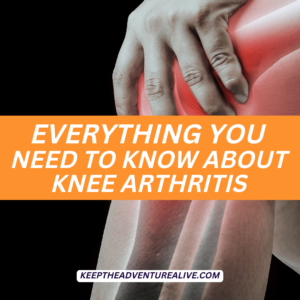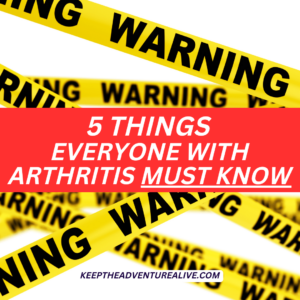If you have arthritis of the knee, walking longer distances can become quite the challenge. If you have a trip coming up, want to return to neighborhood walks with your friends or walk around Costco, this article is for you. As a physical therapist I often find people are commonly missing important movements in their training. To become better at walking, the answer is not just more walking. Let’s see why.
What walking requires
When you are walking, you are asking each of your legs to accept your full bodyweight over and over again. You also have to be able to bend your ankle and knee to push off to the next step.
If you are unable to put all of your weight on one leg you may see why walking may be hard.
If you have arthritis of the knee, that can impede the bending and straightening of the joint. Your leg may also have a heaviness feeling that makes it hard to lift.
If you have had a history of an ankle or foot injury or have osteoarthritis in either joint- it can also make walking hard.
Walking longer distances also requires stamina. If your muscles fatigue too quickly and you get tired, you may be putting more stress on your joints causing irritation, thus pain.
As you can see, walking does require different pieces in order for you to be successful. This also explains why simply more walking may not help if you are lacking range of motion, muscle strength, and/or stamina.
If you’d like to get a jumpstart on walking with ease, try out the FREE 3 Day Arthritis Walking Workout Challenge! It’s perfect for beginners and for those who are looking to get started in improving ability to walk longer distances.
How to get better at walking with arthritis of the knee
Walking is something that is vital to most of our lives. If you are limited in the distance you can walk, you may notice it becomes harder to do a lot of things. For example, a simple trip to the grocery store is no longer “simple”. OR you may have to say no to going on a trip because of the walking it may include.
In order to keep your freedom to roam around how you please, you have to do a few things to keep your joints happy.
This video below will give you an introduction into how to get better at walking longer distances.
There are certain things you have to keep in mind when trying to improve your ability to walk longer distances.
It is possible to feel good when walking longer distances. You can build the stamina and strength with the right movements to help strength, balance and stamina. Here are powerful wins specifically from Adventurers for Life members. Adventurers for Life is my signature membership helping you open the doors to adventure with arthritis.


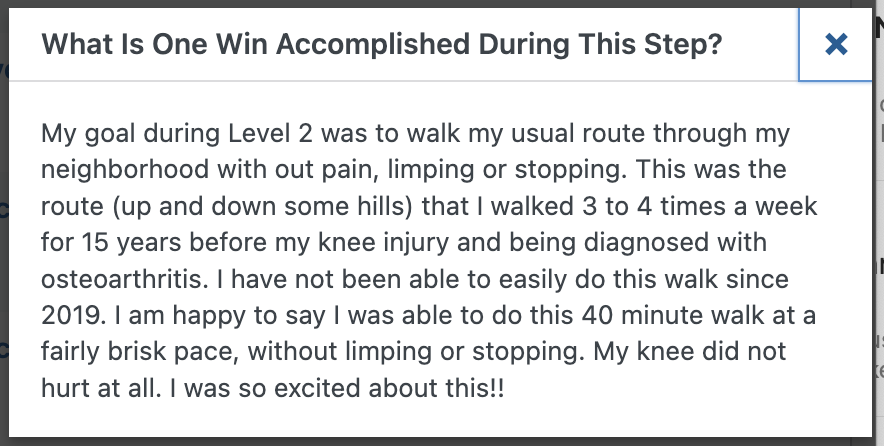
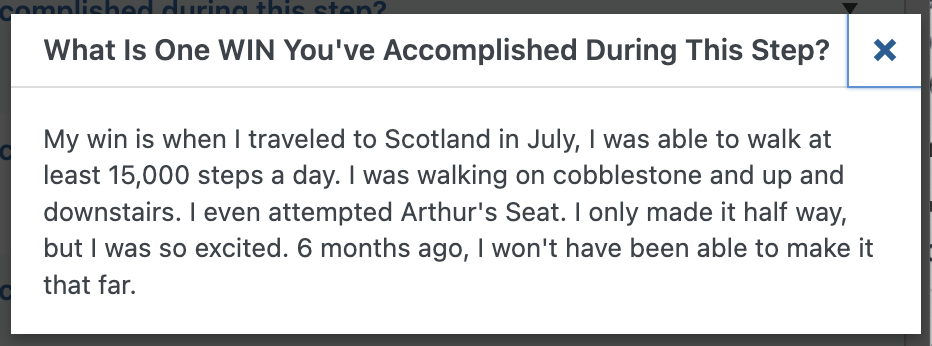
Once your joints are prepared in the right way, doors swing open to what you can accomplish.
5 ways to walk longer distances with arthritis
Walking requires 5 things in particular that I will discuss in more detail below.
These are common things that most people miss and can actually hold you back from accomplishing your goals.
1. Putting your weight on one leg
It is imperative for you to be able to stand with all of your weight on one leg if you’d like to get better at walking.
Don’t worry though, if it is painful right now to stand on one leg, there are ways to build up to it!
If you currently walk with a limp, one of the reasons could be that your body doesn’t trust you to be on one of your legs for a longer period of time. Instead, it tries very hard to keep you off that leg.
For example, if you limp every time you take a step with your left leg- your body wants to spend as less time on that leg as possible and more time on the right side. That’s why it makes the step short and you have to then compensate with the right leg.
In order to get better at this though, there are a few things you can try.
For example, you can try this exercise below called multi-directional stepping. Feel free to use a chair or other stable support to offload bodyweight and for extra stability. Complete 5-8 total reps each side and practice a few times per week!
If you’re specifically experiencing pain on the inside of your knee, read more on that here.
2. Joint mobility
As I mentioned earlier, how your joints move can dictate how you walk. For example, commonly with arthritis of the knee- you may notice stiffness and/or pain limits range of motion.
If you aren’t able to straighten one leg all the way- you may notice a limp or feel like you are “waddling”. This is because the leg that you aren’t able to straighten now is technically shorter than the other. The imbalance can then cause a limp.
It is important to make sure your knee can bend and straighten to full range of motion if possible. If you don’t currently have full range of motion in straightening, here is an example of a movement that can help with that:
Try to complete this exercise for 2-10 minutes depending on comfort level. It should not increase pain significantly.
The ankle joint was mentioned above as well. Your ankle and toes needs to bend enough that you are able to push off from your toes and propel yourself forward. See the two pictures below for reference.
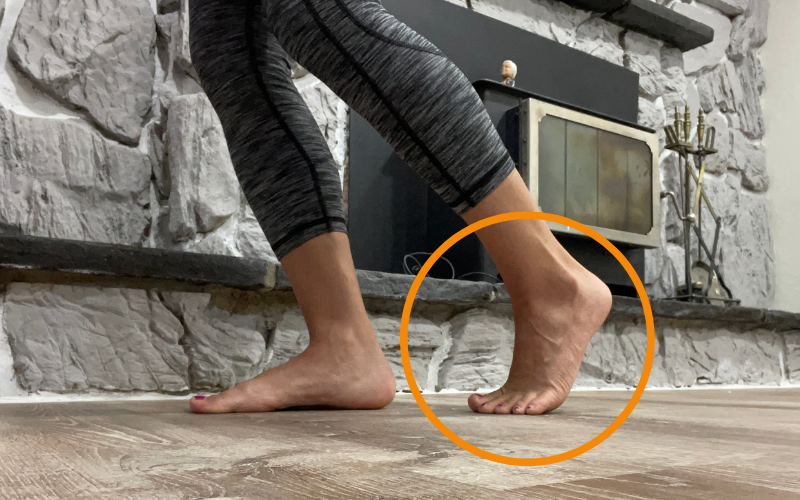
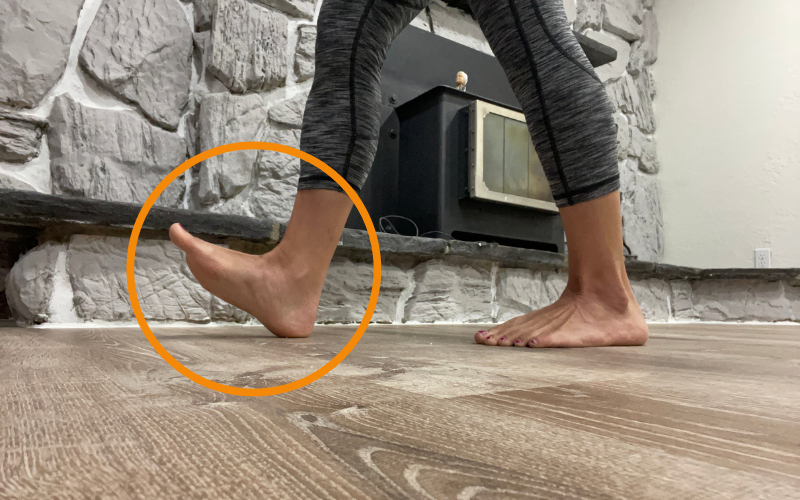
If your toes, primarily your big toe is stiff whether from a previous injury or surgery, you may notice your foot turns out a little bit with each step. This can impact the distance you are able to walk because it is not a normal loading pattern for the joint.
If your ankle is stiff, you may feel like you are shuffling or aren’t able to clear your foot from the ground. If your foot slaps the ground and you feel as though you don’t have control over the lowering, you could have what’s called a drop foot.
In order to keep these joints moving as optimally as possible especially if having to walk up hills, here is one exercise below that can help. Please note this is meant to feel good. If any of these exercises cause significant pain- this might not be the exercise for you.
3. Appropriate balance
Balance is incredibly important when it comes to walking. This is because when you are balancing, all of your muscles are working together at once to support your joints and keep you upright.
If you tend to lose your balance, you may have some muscles that aren’t working as optimally as they should. Find out more on balance here.
If you have arthritis of the knee, you may notice that your balance isn’t as great as it once was. This is because pain can impact balance.
But, the good news is it can be improved upon!
Once you improve your balance, your muscles likely will be able to help support your joint like they should.
You may also feel less instability and more confidence when walking longer distances.
Improving balance with arthritis of the knee is totally possible! Here are a few of my favorite balance movements in this video below.
4. Stamina
Think about how long you would like to walk for. Maybe it’s 10 minutes, maybe it’s an hour or more.
In order to build up the stamina to do so, you have to make sure your joints can support you for that length of time.
For example, I was recently talking with someone who was dealing with knee osteoarthritis and was trying to train for a trip she was taking in 2 months. At the time, she could only walk about 0.5 miles before her pain became limiting.
She felt she had reached a plateau. She was doing some movement for exercise but wasn’t seeing much improvement in the distance she could walk.
After further digging, her typical exercise routine lasted for about 10 minutes per day.
Don’t get me wrong, moving consciously for 10 minutes per day is helpful but if you have aspirations of walking 30+ minutes, it is important to start working towards that goal!
This is by no means stating you should just bump up from 10 to 30 minutes right away. It needs to be gradual so you don’t experience a flare up. Typically this is usually about a 10% increase but may vary person to person.
Here is one workout below that is about 30 minute but can start to push your stamina. Listen to your body and rest as needed. You can also split the video up into parts you complete on separate days if needed!
5. Confidence
One of the biggest components of walking longer distances is building confidence, especially with arthritis of the knee.
I know it may be easier said than done. But it is important to make sure you are on the right path.
Research has actually shown that if you believe you have the ability to accomplish or perform a task, also known as self-efficacy, it can have a positive effect on both pain and physical activity levels.
If you don’t believe you can do a certain task or that it is even possible, it can negatively impact your motivation and your confidence.
One way to build confidence is to make sure you are taking the appropriate steps to accomplish your goals.
Extra Walking Tips
In helping to build strength in the right areas, improve balance and catapult your confidence when walking on all surfaces, this video below gives two of my favorite exercises as a physical therapist to improve walking.
These may need to be modified depending on pain level present, range of motion and strength levels but can be a great place to walk better with arthritis of the knee and hip.
How to be Successful
In order to reach your walking goals with arthritis of the knee, it is important you follow the explained steps above.
It is imperative to know that you need to listen to your body to avoid overdoing certain activities. Pain is a way our bodies communicate with us.
It is also important to challenge your body. The right amount of challenge can help you to unlock your goals and accomplish amazing things.
If you are looking for a place to start- the FREE 3 Day Walking Workout Challenge is a great next step. You’ll get 3 follow along workouts with me, implementing what we discussed in this article and more. Click the button below to sign up.
I want you to know what is possible and how to get there. Now you have the path to do so. Cheers to your adventure!

Alyssa Kuhn
Disclaimer: This post is for general informational purposes only. It should not be used to self-diagnose and it is not a substitute for a medical exam, cure, treatment, diagnosis, and prescription or recommendation. It does not create a doctor-patient relationship between Dr. Kuhn and you. You should not make any change in your health regimen or diet before first consulting a physician and obtaining a medical exam, diagnosis, and recommendation. Move Well Age Well, LLC and Dr. Alyssa Kuhn, PT, DPT are not liable or responsible for any advice, course of treatment, diagnosis or any conclusions drawn, services or product you obtain through this post, video or site. Complete all exercises at your own risk.

If you are looking to regain your active life but are unsure where to start, join the revolutionary membership, Adventurers for Life. This is a step-by-step path that not only will help you find pain relief but will help you unlock adventure. You’ll get workouts, tests to pass to make sure you are on the right track, community events and MORE.

